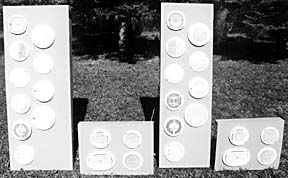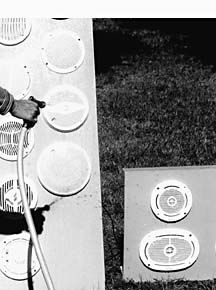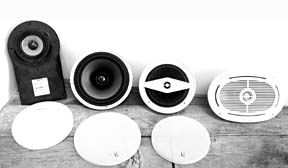Everyone likes music, and though there are wrong times for it on the water (such as when navigating through a fog, or in a harbor where people relish the peace and quiet), listening to your favorite tunes can certainly make a good thing on the water even better.

Speakers, of course, are critical components in any stereo system. Quality speakers can make a so-so receiver sound good; and by the same token, poor speakers can ruin the sound coming from a top-quality receiver.
The speakers and receivers should be matched in terms of power, usually expressed in watts. Cheap, low-power receivers may not be able to drive expensive power-hungry speakers. Similarly, low-rated light-duty speakers can be blown out by high-powered receivers and amplifiers.
Previous evaluations of marine stereo speakers appeared in the July 1993 and April 1994 issues, and were not specifically restricted to waterproof models. On seeing how many dozens of “marine” speakers exist, we decided to limit this evaluation to round, flush-mount, waterproof stereo speakers. Admittedly, this is somewhat arbitrary, but amongst waterproof models round speakers seem to outnumber rectangular shapes, and flush-mount models are preferable outside for cockpit or console mounting. We did miss examining the better-quality box speakers, like the Bose 151 Environmental speakers – and there were plenty of other round speakers that we just couldn’t fit in. One set, from West Marine, was left out because of an ordering mix-up. In a letter to us, West Marine’s Chuck Hawley made the following points:
“1. Bigger woofers are better. 2. The industry assumes that since you have a loud engine or wind noise, you don’t care about distortion in amps and speakers. 3. There’s virtually no standardization in power ratings. 4. Speakers are good for two years in most boating environments. Then, just replace the damned things. They may fade or discolor, but it’s a tough life.”
Assuming that Hawley is correct in his last point, it presents a good argument for buying cheap, decent-sounding speakers rather than expensive, excellent-sounding ones. We’d be interested in hearing from readers about the longevity of their speakers, relative to the kind of life they lead. Longevity is a gear characteristic that we can evaluate all too rarely in these pages.
In any case, we did end up with a good representative selection.
In past reviews, we first listened to several classical music selections on a high-quality home receiver and CD player with studio monitor speakers. Then each pair of test speakers was wired to the stereo and the same music selections were played again. We concentrated on both strong low-frequency (bass) and high-frequency (treble) parts.
The same methodology was pursued this time, but in addition we followed the first round of listening by dropping the speakers on the ground and then spraying them with a garden hose. Then the speakers were rewired to the player and listened to again to see if any parts had come loose, and if the water affected their performance.
Reading Labels
Many (though not all) of the speaker brands examined have the specifications and installation instructions printed right on the box. Presumably, this saves the cost of printing a separate booklet and stuffing it inside. In either case, information is minimal. Most (but again, not all) list RMS power capacity, an acronym for root mean square, which basically means the maximum continuous power the speaker can handle. Some manufacturers only list peak power, which is often double the RMS rating. And a few double the peak rating and give it for a pair of speakers – 200W/pair. In this example, the peak rating per speaker is actually 100W and RMS may be 50W or even less.
Note that speakers don’t put out any power; RMS and peak ratings refer to the amount of power they can handle from the receiver.
On packaging and in our description of the speakers below, there are certain terms that may be confusing.
Here’s help.
A 2-way speaker has two elements, in this report probably a main cone and tweeter. A coaxial speaker also has two elements but differs by placement of the second element on the post. All coaxial speakers are 2-way, but not all 2-way speakers are coaxial.
A full-range speaker is one that covers the basic sound range of a woofer, mid-range speaker, and tweeter; that is, about 80-90Mhz to 20Khz.
A dual-cone speaker uses a little piece of light material, aluminum or Mylar, in place of a tweeter to give high-frequency sounds; it is less expensive to make than a 2-way or coaxial speaker. Sometimes this small piece of material is called a wizzer.
What’s ‘Marine?’
Most home and automotive speakers have paper cones, which would readily suffer damage if wetted. Marine speaker cones are generally made of polypropylene or other synthetic material. The cones are suspended inside the frame or basket by a narrow ring of water-resistant material called the “surround.” Since it has to be flexible, the surround often is made of a rubber or other material with similar characteristics.

Other “marine” protections include non-corrosive and UV-resistant plastic or powder-coated metal grilles; coated terminals and voice coil wires, and stainless steel mounting hardware. A few of the speakers tested neutralize the magnetic field of the speaker magnets so there’s less risk of affecting steering compass readings, which could, of course, be dangerous. This is done by the strategic placement of canceling magnets. Even with such protection, however, poly-planar’s Norm Lang recommends keeping them at least three feet from the steering compass.
Aquatronics AMS602W
Made by Audiovox, these speakers arrived separately, without instructions, mounting hardware, or wire. We rated this model average, though on some pieces of music it was among the poorer performers.
Bose 131
As might be expected from this innovative company, the Bose 131 marine speaker, introduced in 1997, is the most different of the lot. Bose uses its Syncom® II computer quality-control system to develop drivers that make great sounding music even from small speakers. Because lack of air behind a speaker compromises performance, a small air chamber in the back of each 131 speaker assures quality sound in any installation. The surround is silicone protected. Bose claims its testing of speakers in a nasty environment shows the 131 will outlast the industry standard (500 hours vs. 300 hours).
Installation of the 131 is a bit more awkward than others in this evaluation, due to its unusual shape. The dual-port enclosure extends to one side of the speaker, so space must be allowed for this. And the 3-1/2″ depth required is the second most of any speaker tested. The short wire leads coming out of the speaker enclosure must be connected to longer wires to reach the receiver, and for this wire acorn nuts are provided.
We had some difficulty getting the nuts to hold, and twice had to fidget with them to maintain a connection. Bose probably has its reasons for this arrangement, but it seemed an unnecessary hassle.
When all is said and done, the Bose 131 delivers sound equal to any in the group. Bass response was very good and high-frequency response was crisp and accurate, or “bright” as they say in the business. They cost a lot of money, but if you want the best, these are probably the ones to buy.
Infinity
Infinity is one of three brands made by ProSpec. The Infinity speakers cost more than the Seaworthy and ProSpec models tested. RMS and peak power ratings for both the round 62m and oval 692m are a whopping 70W and 210W, respectively.
Overall sound quality was very good; we have a slight preference for the 692m over the 62m.
JVC
Two JVC models are mentioned in the chart, and while we listened to both, only one is shown in the photo as both appear identical. The CS-MX612 model is a dual-cone speaker while the CS-MX622 is a 2-way coaxial speaker. The magnet weight of the 612 is 6.4 ounces compared to 8.0 ounces for the 622, and power handling capacity also is slightly different.
The thin stranded wire needs to be well twisted to enter the receiver hole without splaying.
Jensen
This 6-1/2″ coaxial speaker is said by the manufacturer to meet the ASTM B117 saltwater test. Terminals are gold plated. The surround is called Santoprene®. Its RMS and peak ratings are high at 50W and 150W. The MS6501 is one of three models evaluated that provides magnetic shielding. We checked it with several metals and found no magnetism. In case you’re planning to mount your speakers within several feet of a compass, you won’t have any worries. Again, while not common, we have heard of instances where stereo speakers have altered compass readings.
Poly-Planar
Three models were evaluated with progressively higher power-handling ratings, and prices. The MA4056 packaging states “low magnetic field 6″ coaxial speakers.” Our test for magnetism revealed only slight traces, but not much less than the larger MA6600. The big 7″ MA5107 has a powerful field.
The grill of the MA4056 is plastic, whereas the grill of the two larger speakers is powder-coated metal. The metal grilles must be removed for screwing the speaker frame into the mounting surface, and there doesn’t seem to be any easy way of doing this without the risk of damaging the powder coating. (We used a knife point pushed into one of the tiny holes and lifted.) When pressing the grille back into place, care must be taken not to bend the metal. If you’re careful, there’s no problem, but if you start bending the metal here and there trying to get it to fit (the edge has to be pushed in all around), the grille may get permanently bent out of shape.
The MA5107, which has a deep mounting depth of 3-3/4″, and the MA6600 were two of the best sounding speakers. While the MA6600 is pricey at $169.99, the $89.99 MA5107s seem like a good deal.
ProSpec
Besides the Infinity 62M, three ProSpec speakers were evaluated. The dual-cone JBL MS610 has a more expensive mate – the two-way JBL MS620, which has higher RMS and peak ratings (60W and 180W) but is otherwise much the same.
Of the two Seaworthy models, the SEA5612 has a very shallow 1-7/8″ mounting depth, which could be handy in some installations. In terms of sound quality, we were not particularly impressed with these two models.
Labeling on the 5612 says “CD/Digital ready,” which we warned about nine years ago, saying, “Speakers are not digital devices, and the speaker doesn’t know what kind of a sound-generating device it’s wired up to. For the record, a ‘CD Rated’ or ‘CD Ready’ speaker is not necessarily better than one that does not bear this label.”
Standard
Like the Jensen MS6501, the Standard AS201MS is magnetically shielded and called “compass safe” on the package. Sound was average.
Results
Listening to music, really listening, is more difficult than it might seem. Many hours were spent listening to various pieces of music played through each of the 14 speaker pairs. Rating the speakers is subjective, and personal preference certainly plays a role. We noted subtle differences between speakers that we elected not to include in our ratings, simply because they weren’t so much a matter of sound quality as sound difference.

However, we did identify some sound differences as differences in quality, most often when a low-frequency sound wasn’t handled properly by the speaker, the result being a vibrating, fuzzy sound. The better speakers picked up the same sound crisply.
After dropping each speaker board three times, hard enough to pop the grilles on most of the speakers, we sprayed them at close range with a garden hose. No speaker failed and none seemed to show any ill effects from the abuse. We are fairly confident that all 14 are indeed waterproof and suitable for cockpit installation.
The ratings on the chart are on a scale of 1-5, with 1 being poor and 5 excellent. Most of the speakers are rated as 3 or average. Four speakers rated 4 and 4.5. These are the Bose 131, Poly-Planar 5107 and 6600, and the Infinity 692m. In all fairness, the 5107 and 692m are larger than the majority of speakers, so they did enjoy some advantage. But size isn’t everything; witness the 4-1/2″ Bose speaker size.
Among the top four, the overall quality of the Bose speakers is superior, if one includes details such as the manual and wires. The Poly-Planar MA6600 will save you $70 compared to the Bose 131, and it occupies less space behind the mounting surface.
The Poly-Planar MA5107, at $89.99, rates a Best Buy. Note its larger size when looking for a mounting location. But either are simpler to install than the Bose 131. The Infinity 692m is pricey at $199.95, but is still $40 less than the Bose 131, and it sounds great.
Also With This Article
Click here to view “Value Guide: Waterproof Stereo Speakers.”
Click here to view “Installation Tips.”
Click here to view “Securing Speakers Offshore.”
Contacts– Aquatronics, 800/688-3135, www.asa-avx.com.
Bose, 800/367-4008, www.bose.com.
Jensen Audio, 407/333-0900, www.jensenaudio.com.
JVC, 800/252-5722, www.jvc.com.
Poly-Planar, 215/675-7805, www.polyplanar.com.
ProSpec Electronics, 843/849-9037, www.seaworthy.net.
Standard Horizon, 310/532-5300, www.yaesu.com.
































